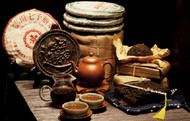The Allure of Pu-erh - Part 2
Posted by Selina Law on Mar 3rd 2017

Different styles of pu-erh tea
This month we continue with our exploration of pu-erh tea. What are mao cha, sheng cha and shu cha? What are the differences among them? How many styles of pu-erh tea are there? As the "pot" thickens, maybe the best way to untangle the mystery is by looking at pu-erh tea’s production processes.
Strictly speaking, only teas that are produced in Yunnan, using leaves from the local bold-leaf variety of tea trees, can be called Pu-erh Tea. From the beginning, even until now, the production processes of pu-erh tea are highly guarded secrets. We have, however, acquired general knowledge about the processes today.
When you go to the store to buy pu-erh tea, you may be asked if you want sheng cha (raw tea) or shu cha (cooked tea). Ultimately, both sheng and shu cha come from mao cha (rough tea). Mao cha is the basic raw leaf material from which to produce sheng or shu cha.
To prepare mao cha, the plucked tea leaves are sorted to remove undesirable materials and let withered, pan fired to minimize oxidation, rolled, and then sun dried until about 90% of the moisture content is removed, followed by a second rolling and sorting. The ready mao cha will then be given for further processing. The producer will decide if the mao cha will be made into sheng or shu cha.
Traditionally, sheng cha was the only type of pu-erh. After the second stage of handling, the mao cha became sheng cha and it would be stored carefully to allow it to age naturally. Over time, the sheng cha’s flavor and aroma would develop, and its color would turn from green to black. This maturation process could take around 10 years. In response to the growing demand for aged sheng cha, tea producers began experimenting with ways to speed up the aging process. In 1972, the Yunnan Kunming Tea Company was reported to have implemented a process in which, in only a few month time, the treated mao cha could mature and develop a mellow taste that was dark and rich like the aged sheng cha. Thus was the beginning of shu cha.
Both sheng and shu cha can come in the style of loose or pressed tea. If they are pressed, they can come in different sizes of cake (round disc), tuo cha (looks like a tiny bowl or bird nest) or brick.


Sheng Cha (left) and Shu Cha (right)

